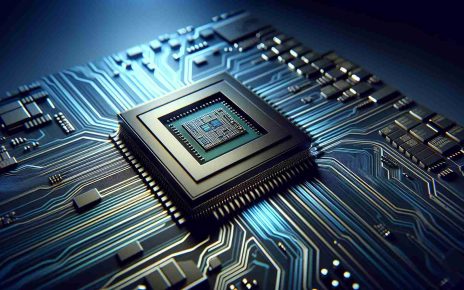- The SAKURA-I AI accelerator is a transformative innovation from EdgeCortix for space exploration.
- It is engineered to withstand extreme space conditions, showing resilience to proton and heavy ion radiation.
- SAKURA-I excels with remarkably low power consumption, ideal for energy-limited space missions.
- Its autonomy allows for swift, independent decision-making, enhancing mission efficiency and safety.
- The accelerator enables longer missions and greater exploration reach with reduced energy reserves.
- SAKURA-I promises intelligent resource management, paving the way for cost-effective, sustainable missions.
In the unforgiving realm of space where technology fights for survival, a groundbreaking innovation emerges: the SAKURA-I AI accelerator. This cutting-edge marvel from EdgeCortix promises to reshape the future of space exploration by tackling some of the universe’s toughest challenges.
Picture a machine engineered not only to withstand but to flourish in extreme conditions. The SAKURA-I is a powerhouse in the harshest environments, showing extraordinary resilience against the relentless onslaught of proton and heavy ion radiation. Imagine NASA’s awe as their rigorous NEPP testing confirmed the accelerator’s flawless operation amidst simulated space storms, proving its capability to endure the vast cosmic frontier.
But the SAKURA-I does more than just survive; it excels with its remarkably low power consumption, making it the perfect candidate for energy-constrained space missions. This crucial trait allows extended voyages into the unknown, reducing the need for massive energy reserves. As humanity pushes the boundaries of exploration, having tech like SAKURA-I means missions can last longer and reach farther.
The true genius of the SAKURA-I lies in its unrivaled autonomy. Equipped to make swift, data-driven decisions independently of Earth-based controls, it propels missions towards increased efficiency and safety. Imagine a future where spacecraft navigate the stars without waiting for commands from home base—charting their course, adapting on-the-fly, and unlocking cosmic secrets on their own.
As we stand on the edge of cosmic innovation, the SAKURA-I AI accelerator heralds a new era. With its promise of intelligent resource management, it paves the way for cost-effective and sustainable missions, ensuring that AI becomes our steadfast partner in unraveling the mysteries of the universe. 🚀✨
Revolutionizing Space Exploration: The Unstoppable Power of the SAKURA-I AI Accelerator
Pros and Cons of the SAKURA-I AI Accelerator
– Pros:
– Radiation Resilience: The SAKURA-I stands out with its extraordinary ability to withstand radiation prevalent in space, specifically proton and heavy ion radiation. This ensures longer operational longevity without the risk of malfunction or data corruption.
– Autonomous Functionality: With capabilities for making independent, real-time decisions, the SAKURA-I greatly enhances mission efficiency and safety, minimizing the need for constant communication with Earth.
– Energy Efficiency: The low power consumption feature is a game-changer for long-term missions with constrained energy supplies, offering more extended operations and exploration times.
– Cons:
– High Initial Costs: As a cutting-edge technology, the initial deployment costs may be high, potentially making it less accessible for smaller missions or organizations.
– Integration Complexity: Incorporating the AI accelerator into existing space systems may require significant technological adjustments and testing phases.
Key Features and Specifications
– Durability: Engineered to perform flawlessly under NEPP testing conditions, demonstrating unmatched resilience against cosmic space environments.
– Energy Consumption: Offers remarkably low power usage, crucial for missions with limited energy resources and extended timelines.
– AI Capabilities: Advanced autonomy for real-time decision-making without Earth command dependence, enhancing both mission safety and efficiency.
Market Analysis and Future Predictions
– Growth Potential: With the increasing demand for autonomous systems in space exploration, the market for AI accelerators like the SAKURA-I is anticipated to grow significantly. This growth will be driven by the need for advanced, sustainable, and cost-effective space mission solutions.
– Sustainability in Space Missions: Future space programs are expected to prioritize the integration of intelligent technologies like SAKURA-I to promote sustainable practices. This will include reducing the environmental impact of launches and operations through efficient resource management and energy use.
FAQs
1. How does the SAKURA-I AI accelerator improve space mission autonomy?
The SAKURA-I AI accelerator enhances autonomy by enabling spacecraft to make real-time, data-driven decisions independently, reducing reliance on constant Earth-based communications and allowing for more flexible and efficient mission operations.
2. What are the main challenges in integrating the SAKURA-I AI accelerator into current systems?
The primary challenges include ensuring compatibility with existing spacecraft systems and addressing the high initial integration costs. This involves extensive testing and potential redesigns to accommodate the AI accelerator’s unique capabilities.
3. Why is the SAKURA-I’s energy efficiency significant for space exploration?
The SAKURA-I’s energy efficiency is crucial as it allows spacecraft to operate longer with limited resources, reducing the need for large energy reserves. This capability is essential for long-duration missions exploring distant and energy-scarce environments.
For more information on space technology innovations, visit NASA’s official site or explore EdgeCortix innovations at EdgeCortix.



